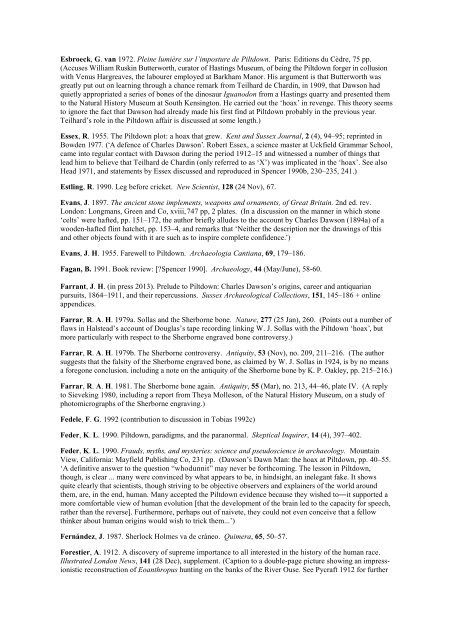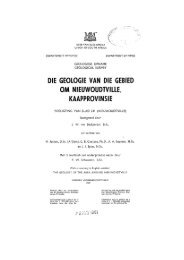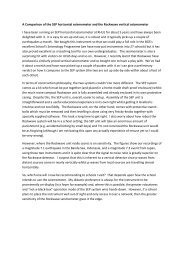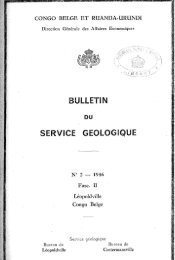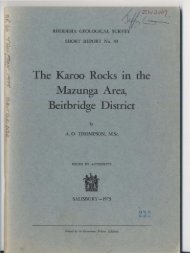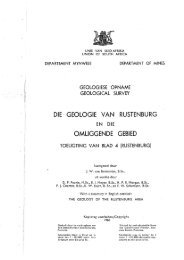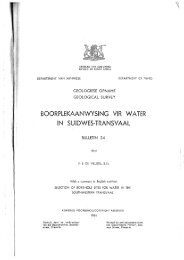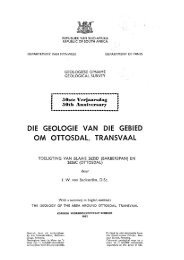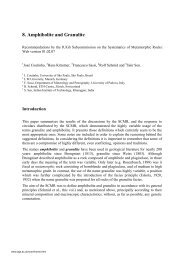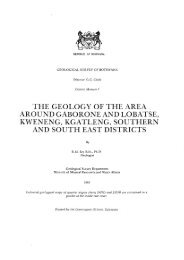Bibliography - British Geological Survey
Bibliography - British Geological Survey
Bibliography - British Geological Survey
You also want an ePaper? Increase the reach of your titles
YUMPU automatically turns print PDFs into web optimized ePapers that Google loves.
Esbroeck, G. van 1972. Pleine lumière sur l’imposture de Piltdown. Paris: Editions du Cèdre, 75 pp.<br />
(Accuses William Ruskin Butterworth, curator of Hastings Museum, of being the Piltdown forger in collusion<br />
with Venus Hargreaves, the labourer employed at Barkham Manor. His argument is that Butterworth was<br />
greatly put out on learning through a chance remark from Teilhard de Chardin, in 1909, that Dawson had<br />
quietly appropriated a series of bones of the dinosaur Iguanodon from a Hastings quarry and presented them<br />
to the Natural History Museum at South Kensington. He carried out the ‘hoax’ in revenge. This theory seems<br />
to ignore the fact that Dawson had already made his first find at Piltdown probably in the previous year.<br />
Teilhard’s role in the Piltdown affair is discussed at some length.)<br />
Essex, R. 1955. The Piltdown plot: a hoax that grew. Kent and Sussex Journal, 2 (4), 94–95; reprinted in<br />
Bowden 1977. (‘A defence of Charles Dawson’. Robert Essex, a science master at Uckfield Grammar School,<br />
came into regular contact with Dawson during the period 1912–15 and witnessed a number of things that<br />
lead him to believe that Teilhard de Chardin (only referred to as ‘X’) was implicated in the ‘hoax’. See also<br />
Head 1971, and statements by Essex discussed and reproduced in Spencer 1990b, 230–235, 241.)<br />
Estling, R. 1990. Leg before cricket. New Scientist, 128 (24 Nov), 67.<br />
Evans, J. 1897. The ancient stone implements, weapons and ornaments, of Great Britain. 2nd ed. rev.<br />
London: Longmans, Green and Co, xviii,747 pp, 2 plates. (In a discussion on the manner in which stone<br />
‘celts’ were hafted, pp. 151–172, the author briefly alludes to the account by Charles Dawson (1894a) of a<br />
wooden-hafted flint hatchet, pp. 153–4, and remarks that ‘Neither the description nor the drawings of this<br />
and other objects found with it are such as to inspire complete confidence.’)<br />
Evans, J. H. 1955. Farewell to Piltdown. Archaeologia Cantiana, 69, 179‒186.<br />
Fagan, B. 1991. Book review: [?Spencer 1990]. Archaeology, 44 (May/June), 58-60.<br />
Farrant, J. H. (in press 2013). Prelude to Piltdown: Charles Dawson’s origins, career and antiquarian<br />
pursuits, 1864–1911, and their repercussions. Sussex Archaeological Collections, 151, 145–186 + online<br />
appendices.<br />
Farrar, R. A. H. 1979a. Sollas and the Sherborne bone. Nature, 277 (25 Jan), 260. (Points out a number of<br />
flaws in Halstead’s account of Douglas’s tape recording linking W. J. Sollas with the Piltdown ‘hoax’, but<br />
more particularly with respect to the Sherborne engraved bone controversy.)<br />
Farrar, R. A. H. 1979b. The Sherborne controversy. Antiquity, 53 (Nov), no. 209, 211‒216. (The author<br />
suggests that the falsity of the Sherborne engraved bone, as claimed by W. J. Sollas in 1924, is by no means<br />
a foregone conclusion. including a note on the antiquity of the Sherborne bone by K. P. Oakley, pp. 215‒216.)<br />
Farrar, R. A. H. 1981. The Sherborne bone again. Antiquity, 55 (Mar), no. 213, 44‒46, plate IV. (A reply<br />
to Sieveking 1980, including a report from Theya Molleson, of the Natural History Museum, on a study of<br />
photomicrographs of the Sherborne engraving.)<br />
Fedele, F. G. 1992 (contribution to discussion in Tobias 1992c)<br />
Feder, K. L. 1990. Piltdown, paradigms, and the paranormal. Skeptical Inquirer, 14 (4), 397‒402.<br />
Feder, K. L. 1990. Frauds, myths, and mysteries: science and pseudoscience in archaeology. Mountain<br />
View, California: Mayfield Publishing Co, 231 pp. (Dawson’s Dawn Man: the hoax at Piltdown, pp. 40–55.<br />
‘A definitive answer to the question “whodunnit” may never be forthcoming. The lesson in Piltdown,<br />
though, is clear ... many were convinced by what appears to be, in hindsight, an inelegant fake. It shows<br />
quite clearly that scientists, though striving to be objective observers and explainers of the world around<br />
them, are, in the end, human. Many accepted the Piltdown evidence because they wished to―it supported a<br />
more comfortable view of human evolution [that the development of the brain led to the capacity for speech,<br />
rather than the reverse]. Furthermore, perhaps out of naivete, they could not even conceive that a fellow<br />
thinker about human origins would wish to trick them...’)<br />
Fernández, J. 1987. Sherlock Holmes va de cráneo. Quimera, 65, 50‒57.<br />
Forestier, A. 1912. A discovery of supreme importance to all interested in the history of the human race.<br />
Illustrated London News, 141 (28 Dec), supplement. (Caption to a double-page picture showing an impressionistic<br />
reconstruction of Eoanthropus hunting on the banks of the River Ouse. See Pycraft 1912 for further


